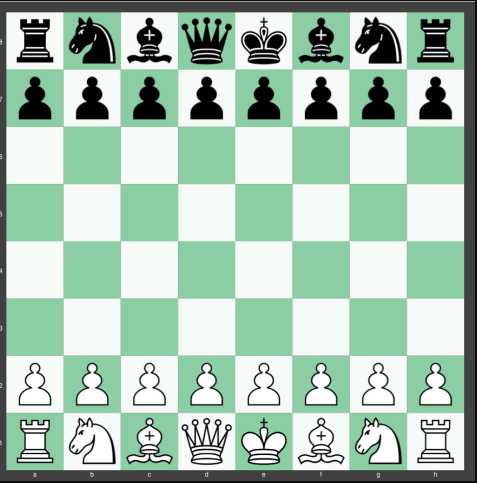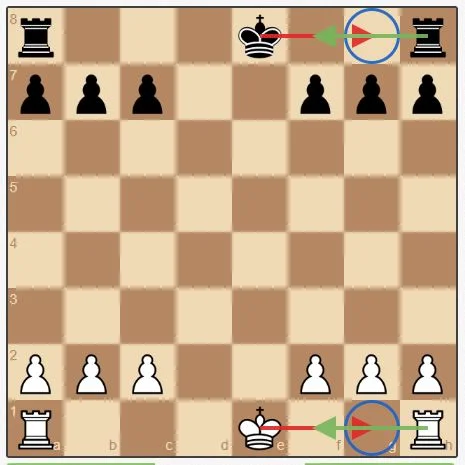The Queen is the most powerful piece in a chess game. It is the most valuable warrior among all the pieces, including the Bishop, Knight, Rook, Pawn and King, due to its strong and versatile moves.
In previous articles, you have learnt about Knight moves in chess, the Bishop moves in chess and kingside Castling. In this article, we will learn the Queen’s movement in chess and answer some questions you may have about it.
History of the Queen in Chess

Originally, chess contained a piece signifying the prime minister, counsellor or vizier. This piece was also known as the Ferz in some cultures and evolved into the Queen over time. The Einsiedeln Poem, written in Latin around 997 was the earliest surviving reference of this piece as a queen or equivalent.
Historian Marilyn Yalom suggests many elements that may have contributed to the piece’s identification as a queen and power in contemporary chess, one of them being the prominence of mediaeval queens such as Blanche of Castile, Eleanor of Aquitaine, and Isabella I of Castile. She cites mediaeval poetry that depicts the Virgin as God’s chess Queen or Fierce Dieu.
Origin of the Modern Queen

In the ancient games, long before the Queen’s powers were enlarged, the Queen was already poetically characterised as crucial to the King’s existence, such that if the queen was lost, the monarch would perish. However, during the reign of Isabella I, the modernization of the Queen’s moves began as the people were greatly inspired by her tremendous political authority and achievements including the discovery of printing and the 1492 expulsion of Jews from Spain. The expelled Jews bought the new chess rule with them as they left, thus, popularising the Queen.
During the 15th century, the Queen’s move evolved into its present form as a blend of the Rook’s move and the Bishop’s. Beginning in Spain, this new form – known as “Queen’s chess” or, more derogatorily, “madwoman’s chess”, spread quickly throughout Europe, due to the invention of the printing press and the popularity of new chess manuals. However, the new guidelines sparked outrage in certain areas, ranging from fear of a powerful female warrior figure to outright mistreatment of women in general.
The Different Names of the Queen
The Persian name of the piece, ferz, is retained in Russian. The Russian word koroleva (queen) is informal, so it is never used by professional chess players. The terms korolevna (king’s daughter), tsaritsa (tsar’s wife), and baba (old lady) are, also mentioned as early as 1694. In Arabic-speaking nations, the Queen is still referred to as the vizier. The table below depicts the names of the queen in different countries.
| Language | Queen | Translation |
| Afrikaans | D Dame | lady |
| Albanian | D Dama / Mbretëresha | lady / queen |
| Arabic | و وزير (wazïr) | vizier |
| Belarusian (Taraškievica) | Вз візыр | vizier |
| Bulgarian | Д дама | lady |
| Chinese | Q 后 (hòu) | queen |
| Dutch | D dame | lady / queen |
| English | Q queen | |
| Estonian | L lipp | flag |
| Finnish | D daami / kuningatar | lady / queen |
| French | D dame | lady |
| German | D Dame | lady / queen |
| Greek | Β βασίλισσα (vasílissa) | queen |
| Hindi | V वज़ीर / रानी (vazīr / rānī) | vizier / queen |
| Indonesian | M menteri | minister / vizier |
| Interslavic | C carica / dama | empress / lady |
| Italian | D donna / regina | lady / queen |
| Latvian | D dāma | lady |
| Persian | و وزیر | vizier / minister |
| Polish | H hetman | |
| Portuguese | D dama / rainha | lady / queen |
| Romanian | D damă / regină | lady / queen |
| Russian | Ф ферзь / королева (ferz’ / koroleva) | vizier / queen |
| Spanish | D dama / reina | lady / queen |
| Swedish | D dam / drottning | lady / queen |
| Thai | ต เม็ด / ตรี / มนตรี (met / trī / montrī) | counsellor |
| Turkish | V vezir | vizier |
| Vietnamese | H hậu | queen |
| Welsh | B brenhines | queen |
Basic Queen Moves on the Chessboard

The Queen has a lot of movement options in a game of chess. It can move vertically, horizontally, or diagonally across the chessboard. Therefore, the Queen’s value is given more attention as it has the ability to move like a rook and a Bishop combined.
How Many Steps Can a Queen Move in Chess?
The Queen can move any number of steps in a single move as long as there is no obstruction by its own or an opponent’s piece.
How Should the Queen Be Placed on a Chessboard?

Setting up a chessboard is the first thing you’ll need to do if you want to play chess. As this article is about the Queen, we will be focusing on it and establishing the Queen’s position on the board. To learn about how the other pieces are arranged, read this article by Podium School.
There are two queens in total in the game (black queen and the white queen), each placed next to the king as his strongest protector. They start from their respective colours, that is, the black queen starts from the black square and the white queen starts from the white square. This is why the terms “the dress matches the shoes”, “queen gains her colour”, and “queen on her colour” are employed.
Value of the Queen Piece
The Queen is normally worth nine pawns, which is stronger than a rook and a bishop combined but slightly weaker than two rooks. This is because of the following reasons:
- First, the Queen is more mobile than the Rook and Bishop since the Queen may be moved to another position in one move. However, two movements are required to move the rook and bishop, with the Bishop always confined to squares of one colour.
- Second, the Queen is unaffected by the Bishop’s incapacity to control squares of the opposite colour to the square on which it stands.
The Rook and Bishop have the advantage of being able to attack a square twice, whereas the queen can only do so once. However, previous instances have shown that this drawback is frequently less important than the points in the queen’s favour.
Overall, the Queen is at its strongest when the board is open (the opponent king is weakly protected, or there are loose pieces in the enemy camp). The queen is well-equipped to perform forks due to its vast range and ability to manoeuvre in many directions.
Important Techniques for Using the Queen
The Queen is the most threatening piece on the board since she can move wherever she wants. However, its mobility makes it helpful in several chess strategies. In fact, the queen can bail you out of tricky circumstances or place you in favourable positions at the start of the game. So, let us look at some examples.
The Queen’s Gambit
Like all gambits, it begins with the intention to sacrifice a chess piece. Control of the centre is critical in the early stages of the game, and the Queen’s Gambit allows an ambitious white player to swap a pawn for control of the centre. The Queen’s Gambit is so named because it begins with the queen’s pawn. It is comprised of three moves:
- White advances the queen’s pawn two places.
- Black reacts by advancing its queen pawn two spaces.
- Finally, white responds by moving its queenside bishop’s pawn two spaces forward.

If you prefer to continuously put pressure on your opponent, the Queen’s Gambit is a great opening to study. When used appropriately, it can compel black to spend the first several minutes of the game responding to your threats rather than creating their own.
For more information on the Queen’s Gambit, read the document given below.
Scholar’s Mate
Many beginners release their queen in an attempt to aggressively push their opponent, and the Scholar’s Mate is one method for doing so. In fact, using the Scholar’s Mate, you can checkmate your opponent in just four moves. It is a method of causing major troubles for your opponent. However, you must be cautious when using this move, as this tactic can be easily undone. Therefore, it should only be employed against inexperienced opponents, as advanced players will be familiar with the attack and can rapidly neutralise it.
How to perform the Scholar’s mate:

- Move your King Pawn ahead two spaces to 1.e4. Opening with your king’s pawn enables you to move your white-square bishop and queen, both of which are necessary for the scholar’s mate.
- Transfer your bishop to c4. Because the scholar’s mate is a joint attack between your bishop and queen, developing your bishop right away and targeting your opponent’s f-pawn is one half of the strategy’s preparation.
- Move your queen to h5. Both your queen and bishop are now aiming for your opponent’s pawn on f7.
- Finally, capture the opponent’s f7 pawn. Therefore, your opponent will now be in checkmate and will be unable to counterattack as your queen is guarded by your bishop, and their king is surrounded by the rest of their pieces.
The Kiss of Death

In practice, the Kiss of Death is arguably the most well-known checkmate. It occurs when the Queen launches a diagonal assault on the opposing king while being diagonally backed by her own king, thus ensuring that the opponent does not instantly capture the Queen. It is one of the ways a classic Queen + King checkmate might occur in a Chess Endgame.
You’ll need to play a few games to learn how to set up checkmates like the Kiss of Death, but once you do, it will be second nature.
Sacrificing Pieces to Aid the Queen
When you make a sacrifice, you purposely lose a piece in order to obtain an advantage in terms of position or material. The Queen’s Gambit is a good example of this. In chess, you must occasionally take such risks and lose to place yourself in a stronger position later on.
You can utilise both genuine positional and strategic sacrifices and false sacrifices. Here are a few examples:
- Deflection sacrifice: This is used to divert an opponent’s piece’s attention away from a square so that you can play your sneaky strategy.
- Magnet sacrifice: This is employed to direct an opponent’s piece to a strategically unimportant square.
- Destruction sacrifice: It is employed to remove a materially inferior component in order to play the Queen.
- Suicide sacrifice: This is when a player gives up a piece that can make legal moves in order to achieve a stalemate and obtain a draw in the game that would otherwise be a defeat.
- Clearance sacrifice: When a player seeks to clear the square on which the sacrificed piece is located so that the Queen might take its place.
Final Thoughts
The Queen is the most influential piece in a game of chess. It can move like a bishop, rook, pawn or king, but not like a knight. In championships, tournaments, or just friendly games, don’t underestimate the queen’s strength. Play the piece, but remember to guard her with bishops, knights, and rooks while doing so. Each player has their own style of play, but you can’t perfect it unless you learn the fundamentals, so don’t be afraid to practise by playing games online against other people or computer opponents.
You may also be interested in learning about developing pieces, castling, and en passant. To find out more about these moves, visit Podium School.
FAQs
Is it possible for the Queen to move like a Bishop or a Rook?
Yes, the Queen’s high worth (9 points) because it has the power and influence that stem from her ability to move like a rook or a bishop. This is why, from the opponent’s perspective, the queen is a particularly dangerous piece.
Is it possible for the queen to move in an L-shape like a knight?
The queen has just one limitation: it cannot leap over the other pieces and is thus restricted to the blockage of other pieces. As a result, it cannot move over pieces like a knight and cannot travel in an L-shape. It must always move in straight lines.
Can a queen move backwards in chess?
Yes, in chess, the queen may go backwards without any issues. As previously stated, there should be no impediments to its mobility because it cannot jump over objects.
Why is the queen the strongest in chess?
The queen is strongest in chess because it has the ability to govern a vast number of squares at the same time. Furthermore, it has the choice of defending the warriors by acting as a wall or the choice of acting as a sword and attacking the opponent’s pieces. The player and the situation in the game decide how the queen is used. Its significance is further demonstrated by the fact that many international chess players have quit the game after their queen has been taken.
How do you get the a lost Queen back in chess?
When a Pawn reaches the eighth rank from its original square (the eighth rank for white and the first rank for black and vice versa), it is promoted. When this occurs, the player has the option of replacing the Pawn with a Queen, Bishop, Rook, or Knight. Most of the time, players will promote a pawn to a Queen, often known as “Queening the Pawn”.
For example, the 2011 game between GM David Anton Guijarro and IM Alejandro Franco Alonso was quite an unusual one as at some point, each player had at least three Queens on the board. Look at the image below for a still from their game.
In chess, can you have two queens?
Yes, as previously stated, you can obtain one or more Queens by moving your Pawn to the last row. There are no restrictions on the number of queens you can have in a game. Of course, because a maximum of 8 pawns can be promoted, you can’t have more than 9 queens.
In chess, can a Queen capture another Queen?
Absolutely, a Queen may be captured by another Queen, particularly if no chess piece protects that Queen. If the Queen is shielded, the invading Queen is also captured. When this movement occurs, it is said that the two Queens have been exchanged.
In chess, may a queen seize two pieces?
Yes, you may lose two pieces in a single move. However, there is a distinction between losing and being taken. Only one piece can be captured in a single move. But, after capturing the piece, if the Queen is in a position such that the opponent’s piece cannot escape capture in the next move, then it is said to be lost.
What exactly Is a queen sacrifice?
A queen sacrifice occurs when a player willingly allows their opponent to capture their queen. The player that offers the queen sacrifice does so in order to obtain an advantage, like a better position, additional material, or a checkmate.
How can you counter the Queen’s Gambit?
There are three ways to counter this opening move. They are as follows:
Salv Defense

The Slav Defense seeks to release black’s light-squared bishop while simultaneously providing black with a strong pawn structure. Its main line is as follows:
- d4 d5
- c4 c6
Because black retained its Pawn on e7, its light-squared Bishop now has a clear path to advancement. White normally answers at this moment by moving its Knight to c3, to which black responds by bringing its own Knight to f6. After three moves, the only difference between the Slav Defense and the Queen’s Gambit Declined (which we will in the paragraphs below) is the position of the second black piece, but that difference opens up a plethora of new options. The general progression is as follows:
- Nf3 Nf6
- Nc6 dxc4
At this time, white will often move its a-Pawn to a4 to prevent black from moving her b-Pawn to b5. Black is also free to advance its light-squared Bishop to f5, following which black may move its e-Pawn to e6, forming a powerful pawn structure capable of contesting the centre without entangling a bishop.
Queens Gambit Accepted(QGA)
This is the second type of counter to the Queen’s Gambit. Until the late 1800s, black’s customary approach to the Queen’s Gambit was to guard the c-Pawn. It needed World Champions Wilhelm Steinetz and subsequently, Alexander Alekhine to demonstrate how the QGA may give black a chance at centre control. The QGA may be written as follows in standard notation:
- d4 d5
- c4 dxc4
From here, most versions of the QGA proceed as follows:
- Nf3 Nf6
- e3 e6
- Bxc4 c5
- 0-0 a6

This has several obvious benefits for white. Firstly, it takes back the black Pawn, secondly, it helps defend the white King, and lastly, it opens up a path for the Bishop. However, it also provides certain benefits to black. If the black b-Pawn can advance to b5, the Bishop on c4 becomes exposed to the black b-Pawn, putting white in an awkward situation.
Queen’s Gambit Declined (QGD)
While there are several compelling reasons for black to accept the Queen’s Gambit, it is more typical for black to reject it. The mainstream version of QGD has a black reply with c4 e6, however, there are more ways to get the same result.
The key advantage of this move is that it frees the black’s kingside Bishop at e6 while hindering its queenside bishop. The crucial point here is that by refusing to play dxc4, black refuses to give away the centre to white until it gains advantage from it. QGD can be written as follows in standard notation:
- d4 d5
- c4 e6
From then, white often answers with Nc3, to which black can react in a variety of ways, the most frequent of which involves answering with its own Knight, thus:
- Nc3 Nf6
- Bg5 Be7
- Nf3

Following the mainstream QGD provides black with a number of excellent possibilities. By advancing a Pawn to h6 or retiring the Knight on f6 to d7, it may castle on the kingside and threaten white’s dark-squared Bishop. Although black still poses a danger to the centre, it also has the chance of ultimately capturing white’s d-Pawn.
Share with your friends





